
Thomas Chatterton Manuscript Project
Key People
Chatterton's Search for a Patron
Chatterton Age: 16
Still an Apprentice at Lambert's
Free Online Access
To all 48 Volumes of The Yale Edition of Horace Walpole’s
Correspondence and Chattertoniana : View

Supposed Portrait of Thomas Chatterton

Horace Walpole

'Chatterton in his Library'


Walpole in his Library
According to the Strawberry Hill website, Walpole spent more than £20,000 on the first stage of the redevelopment of his house - this is a truly vast amount, spent by the man who claimed not to be born to wealth!
After Walpole's death, the majority of his library eventually ended up in the possession of Wilmarth Sheldon 'Lefty' Lewis. He bought most of it from the New York Mercantile Library. It is thanks to 'Lefty' that Walpole is as famous as he is these days - Lefty was a man with perseverance in his blood!
It is said that Chatterton's life was a struggle from start to finish. He had to mix in circles well above his pay grade simply to get sight of or to borrow books. It is also claimed that his mother paid the quarterly fee to Fisher's circulating library. l so he could use a local circulating libraries but, generally, these exalted establishments were restricted to those who could afford the fee, bearing in mind that the average weekly wage for a labourer in 1760, was 7s 6d : view source. According to Meyerstein, Chatterton visited a number bookshops where he was allowed to read the books without payment, and he would also transcribe sections of interest to him.
Learn more about British Circulating Libraries : View online We did have a link to the excellent site British Circulating libraries on Weebly but that seems to have expired. Try the following : View
At some point we have to decide : was Chatterton's life one of poverty or was his family, from a financial perspective, edging beyond working class? Surely his schooling at Colston's and his associations with the likes of Barrett, along with the sterling efforts of his mother, Sarah, who was running her own little Dames School - until she developed cancer - must lift the family a little beyond the basic difficulties of the poor working-class ?
The image below dates, as far as I can tell, from around 1830.
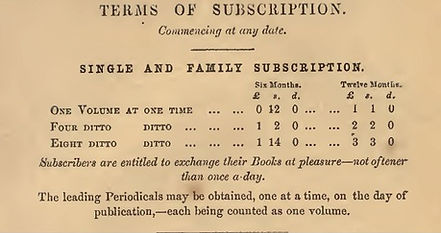
Walpole died 2nd March, 1797, aged 79. The contents of Strawberry Hill went to auction in April of 1842. The sale lasted 24 days.
Chatterton died 24th August, 1770, at 17 years & nine months of age. There was nothing left in his attic room but the clothes he died in, along with a pocket book, some scraps of paper, his pens & ink and other such 'worthless' paraphernalia and, on the windowsill - an empty phial of kill or cure medicine.
It is clear that Walpole was not responsible for the death of Chatterton and, in any case, it is accepted by those of us willing to read the facts, that Chatterton's death was caused by an accidental overdose and not by suicide!
I have to say that I have enjoyed reading the letters and works of Horatio Walpole, Earl of Orford, although I do like to keep in mind that he was in a massively privileged position. It seems to me that he truly believed he was a step or two (or three or more) above the likes of Chatterton, which gave him the right to pass judgment and then to offer advice, which was, basically, keep to your station.
However, you must smile when you read the following excerpt from Walpole's 'A Letter to the Editor of the Miscellanies of Thomas Chatterton, 1779':
‘My fortune is private and moderate; my situation, more private; my interest, none. I was neither born to wealth, nor to accumulate it: I have indulged a taste for expensive baubles, with little attention to economy; it did not become me to give myself airs of protection; and, though it might not be generous, I have been less fond of the company of authors, than of their works.'
Chatterton's Correspondence with Walpole
Published 1789 / 1792,
19 / 22 years after Chatterton's Death
25th March 1769
Walpole was 51 when he received 16 year old Chatterton's first letter.
'The Ryse of Peyncteynge yn Englande.'
Written 25th March 1769. First Published by Barrett, 1789

From Linda Kelly's book, The Marvellous Boy, photograph of the original letter written by Chatterton.
Click images for larger view.
The original manuscript rests at the British Library.
As a treat, click the link to compare an engraving of the above by Charles John Smith : View
28th March 1769
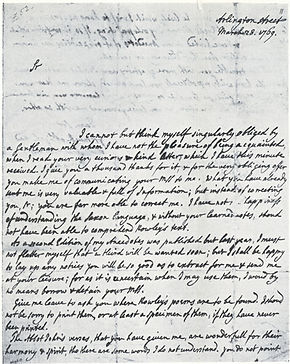

Click the images for a larger view
Written 28th March 1769. Published European Magazine Feb 1792
Walpole was excited and intrigued by Chatterton's letter. He obviously felt that he had no time to lose and wrote back the same day.
30th March 1769
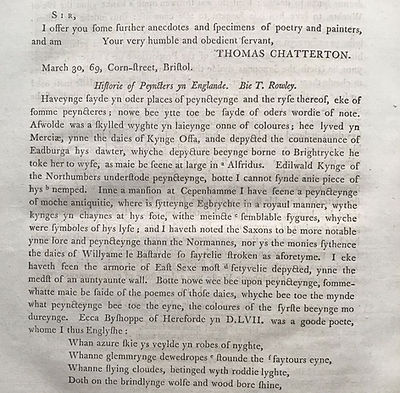
Chatterton's second letter to Walpole, containing his Histoirie of Payncters yn Englande, Stanzas by Ecca, & Elmar, and The Warre, has a complicated history. You would be well served to read the various notes and remarks by the likes of Taylor, Meyerstein, Lort and, of course, Walpole.
6th April 1769
This is the Mysteriously Missing Letter of Rejection
Original Manuscript : Missing, presumed 'lost.'
-
The original letter that Walpole claims he sent to Chatterton, on or about the 6th April 1769 (Taylor suggests 1-7th April), directly after he showed Chatterton's previous two letters to Thomas Gray & William Mason, who both pronounced the works as 'modern forgeries,' is missing, presumed lost.
-
In addition, Walpole’s copy of the letter is also missing, presumed lost, which is surprising considering that he tended to keep copies of his letters. However, we do have - or at least what Walpole purports it to be - a summary of the contents of his missing letter. See First Printing… below.
First Printing : 'Letter to the Editor of the Miscellanies of T. Chatterton 1779', see image below.
-
So, here it is, or what Walpole purports it to be, a summary of the contents of his missing letter to Chatterton, which was published in his 55 page book 'Letter to the Editor of the Miscellanies of T. Chatterton 1779'. View the summary below, or read the complete volume : View online
Additional links:
Walpole's Letter to The Editor of Chatterton's Miscellanies
Printed 1779 at Walpole's Strawberry Hill Press

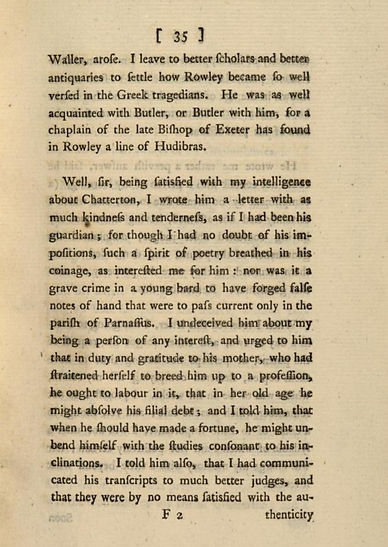
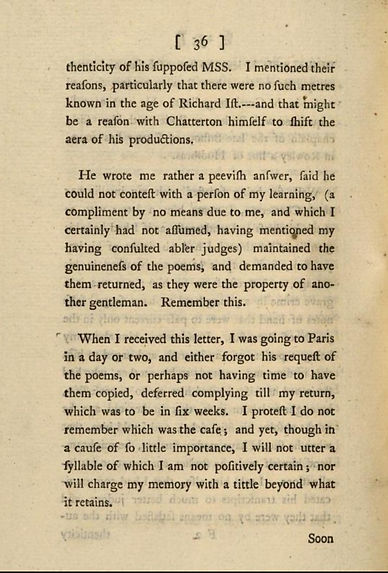
Chatterton's 3rd Letter to Walpole
8th April 1769


The letter is folded in a particular way to form its own envelope and then sealed with red wax.
Click images for larger picture.
The manuscript was presumed lost (as listed by Donald S. Taylor, p.961) but has been rediscovered and is now at Johns Hopkins Sheridan Library. It is part of the Arthur and Janet Freeman collection : View
Chatterton's 3rd letter to Walpole, 8th April 1769; Chatterton is stunned by the rejection and writes back in haste :
"I am not able to dispute with a person of your literary character."
Chatterton also threatens to "destroy all my useless lumber of literature,"
First Printing : in Walpole's Works, 1798, p.236 : View
Sold at Christie's 28 June 1995, for £10,350 + hammer.
Chatterton's 4th Letter to Walpole
14th April 1769


The letter is folded in a particular way to form its own envelope and then sealed with red wax.
Click images for larger picture.
The Ms. was presumed lost - but has been rediscovered and was one of four items in the Bonham sale of 14 November 2023 : View
Chatterton's letter to Walpole (the 3rd draft), dated 14th April 1769, where he demands the return of his letters but is ignored by Walpole.
Three drafts of this letter were written:
-
1st draft : Chatterton's handwriting : Pub. 1803.
-
2nd draft : Barrett's handwriting : Pub. 1803.
-
3rd draft : Chatterton's handwriting : Pub. Walpole's Works, 1798.
The note in black ink at the foot of the letter is in the handwriting of Walpole.
Read the Control Page for this Letter : View
Chatterton's 5th Letter to Walpole
24th July 1769


The letter is folded in a particular way to form its own envelope and then sealed with red wax.
Click images for larger picture.
The manuscript was presumed lost, but resurfaced as one of four items in the Bonhams sale of 14 November 2023 : View
'Sir, I cannot reconcile your behavior to me...'
The letter was written, 24th July 1769, and first published in The Works of Horatio Walpole, 1798, p.237.
Chatterton's Lines to Walpole

From Dix p.102
Chatterton in his pique wrote his Lines on Walpole :
-
'Walpole! I thought not I should ever see...'
He also added this note :
-
'Intended to have sent the above to Mr. Walpole but my Sister perswaded me out of it.
The first printing was in Dix, p.102, 1837, which left Donald S. Taylor a little concerned, but Meyerstein accepted it as Chatterton's.
Nick Groom wrote 'The Case Against Chatterton's 'Lines to Walpole' and his 'Last Verses.' We hope to have copies of it here in due course. If you are an academic you might be able to get access to it : View
Walpole's 3rd (Final) Letter to Chatterton
Not sent - 4th August 1769


Click images for larger views.
The Ms. was presumed lost - but has been rediscovered and was one of four items in the Bonham sale of 14 November 2023 : View
Walpole returns Chatterton's 'Manuscripts
'Sir, I do not see, I must own, how those precious MSS. of which you have sent me a few extracts, should be lost to the world by my detaining your letters. Do the originals not exist,...'
Walpole wrote this letter to go with the 'Rowley' papers he was returning to Chatterton, but decided to send the papers in a plain cover without the letter. He claimed that he had thrown the letter into the fire but then in 1783/84 he found the letter unburnt and included it in his Collected Works of 1798. The letter is a genuine Walpole construct but we must make up our own minds re the veracity of the contents.
-
The Works of Horatio Walpole, 1798, p.237 : View
Lady Lyttelton's Card to Walpole

Recto : Lady Lyttelton's card to Walpole

Verso : Lady Lyttelton's card to Walpole
Lady Lyttelton's card to Walpole, reused by Walpole to record on the verso, the return of Chatterton's Mss.
Written : 4th August 1769. The card was sold at Bonham's, along with Chatterton's 4th and 5th letters to Walpole, and Walpole's 3rd (unsent) letter to Chatterton.
Walpole's 'Last Declaration Respecting Chatterton'
Walpole's 'Last Declaration Respecting Chatterton' was published in The Works of Horatio Walpole, 1798, v4, p.240. The fourth paragraph is a delight. It shows Walpole covering all angles to defend himself, even after death, and states that if the missing letter does appear after he has died and it tells a different story to what he claims the truth to be, then it will be a forgery.
Meyerstein suggests that "maybe Chatterton destroyed it [the letter] in a fury without communicating the whole to Barrett." See Meyerstein, p.261
Finally, I must, yet again, defend Walpole and add that no right minded person would charge Walpole with causing the death of Chatterton. It should also be mentioned that Walpole, when writing about Chatterton, is a picture of contradictions, on the one hand praising Chatterton's works, on the other calling him a rascal.
The Works of Horatio Walpole, 1798

View above, click image for larger view or Click to View online
Walpole's Publications
How important is W. S. Lewis's Walpole edition (1951), volume 16, in relation to Chatterton?
Well now, thanks to the Lewis Walpole Library (Yale University), you can judge for yourself ! They have, rather wonderfully and without restrictions, put the whole 48 volumes online - and free to all. Click the View links above to read or search the Chatterton sections.
To read or search through all 48 volumes : View
Walpoliana : Anecdotes, etc., 1799.
Includes mention of Chatterton in Vol 1 View Vol 1 View Vol 2. *
"I think Chatterton was an astonishing genius"


"I think Chatterton was an astonishing genius"
So says Walpole in his letter to Rev. Cole, 19 June 1777 (only part of the letter is shown here). I think it fair to say that Walpole was a walking, talking but mainly a writing contradiction; he treats Chatterton as a Hero and a Villain or, rather, a Genius and a Villain depending on who he was talking to or corresponding with. The copy of this letter is from the book 'Historical and Literary Curiosities,' 1847. My goodness but Walpole wrote and received so many letters - he must have spent most of his time sat at his desk in his library, and thank goodness for that, as many of his letters are a real treat!
The whole of the letter in this section, as well as the rest of Walpole's correspondence, can be viewed in an easier to read transcript at : Yale editions. (Note that you must scroll down the page to the letter dated 19th June).
Here is the nub of Walpole's letter :
"...If any man was to tell you that monkish rhymes had been dug
up in Herculaneum which was destroyed several centuries before
there was any such poetry, should you believe it? Just the reverse is
the case of Rowley's pretended poems. They have all the elegance of
Waller and Prior, and more than Lord Surry—but I have no objection
to anybody believing what he pleases.
I think poor Chatterton was an astonishing genius—
but I cannot think that Rowley foresaw metres
that were invented long after he was dead, or that our
language was more refined at Bristol in the reign of Henry V than
it was at court under Henry VIII. One of the chaplains of the
Bishop of Exeter has found a line of Rowley in Hudibras—the
monk might foresee that too!
The prematurity of Chatterton's genius is however full as wonderful,
as that such a prodigy of Rowley should never have been heard of till the eighteenth century.
The youth and industry of the former are miracles too, yet still more credible..."
Horace Walpole - Links Online
-
House & Garden - Strawberry Hill : Main Site : View
-
House & Garden - Strawberry Hill : Treasure Hunt : View
-
Strawberry Hill Youtube Video 2 : View
-
Yale University : Lewis - Walpole Library : View
-
Yale University: Horace Walpole at 300 Blog : View
-
Serendipity : Letter to Horace Mann Jan. 28, 1754 : View
-
All 48 Volumes The Yale Edition of Horace Walpole's Correspondence and Chattertoniana : View





